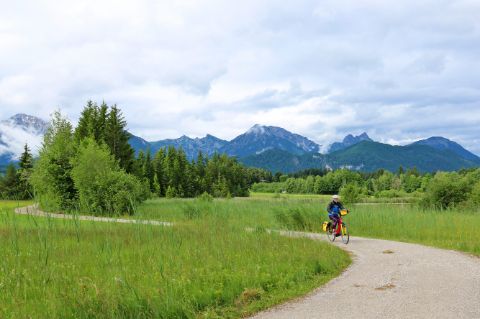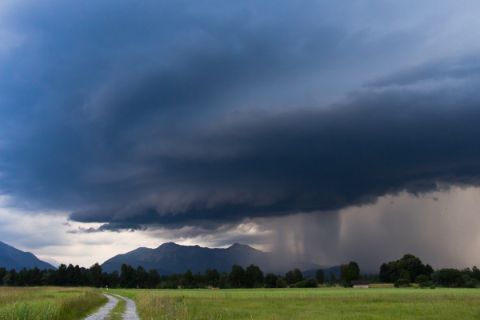The right behaviour in bad weather
There’s a storm and you are on the bike. The question is what to do in such a situation? Isolate the tires? Is the metal frame of the bike attract lightning? Or on the contrary, does it even divert lightning? Question after question, and the Eurobike team have the answers.
A metal bike does not attract lightning, but the metal has a conductive effect. Unlike a car, a bike is not a Faraday cage. Unfortunately, the rubber tires do not protect you. Therefore: as soon as a thunderstorm begins, keep at least 10m away from the bike. If lightning actually strikes, it spreads across the floor and you could be injured.
Measure the distance of the thunderstorm: It is important to count the seconds between lightning and thunder. Divide the number by three to get the distance of the thunderstorm in kilometres. Why is this so? Quite simply: the sound propagates at a speed of 333 metres per second, i.e. around one kilometre in three seconds.
The best shelters during thunderstorms are reinforced concrete houses or bridges. These act as lightning rods and you will be safe. If you are cycling in open terrain, quickly move away from the bike and look for the lowest point. There you should take a protective posture: arms over your head, crouch down and wait. Please avoid freestanding trees in the forest! The same applies in the forest as in an open area: search for a point as deep as possible.
Cycling technique in rainy weather
It depends on the technology. Braking is significantly reduced in the rain. Therefore, especially when cycling downhill, make sure to brake both brakes dry with repeated short pulls. The full braking force can be achieved this way. First, to avoid the wheels locking, the front and rear brakes should be pulled simultaneously. Secondly, it is advisable to use the brakes in a metered manner.
As already explained, you should also rethink the steering in bad weather. In addition to throttling the pace before a curve, it is important to cycle with foresight. Whether dense fog, a slippery road or large puddles – in rainy weather you should exercise caution when cycling.
5 tops for cycling in bad weather
- If in doubt, always pack rain protection. Functional clothing is also easy to store and can really protect you when it pours.
- Waterproof overshoes not only ensure comfortably warm feet, they also protect against wetness and fight the cold.
- A new bike is good and beautiful, but you should be particularly careful with new bike tires. They can be very slippery at first and should definitely be tried out in good weather.
- Pay attention to the road surface! Rain and street dust as well as mossy forest floor can have slippery spots – there’s a risk of falling!
- Even though there’s water all around you – don’t forget to hydrate. Because even when water is falling from above, the body loses fluid through physical exertion. And you should replace it sufficiently.
What clouds tell you…
If you are able to interpret the language of the clouds you have a clear advantage. For then rain and wind have no chance to spoil your cycling tour unexpectedly.
Clouds in all altitudes:
- Nimbostratus clouds: typically grey rain- or snow clouds, which appear dark underneath.
- Cumulus clouds: dense, radiant white water-clouds, dark underneath. They feature clear boundaries. If they form around midday and dissolve in the evening, it remains sunny. However if they appear in the morning or in the evening, the weather often gets worse.
- Cumulonimbus clouds: large, thick cumulus clouds hulking up. They are known as the classic thunderstorm clouds.
High clouds: 5 to 13 kilometres
- Cirrus- or feathery clouds: thin, fuzzy clouds consisting of ice crystals, quite often announce a warm front with rain.
- Cirrocumulus clouds: white, thin ice crystal-clouds, often promising a mighty thunderstorm.
- Cirrostratus clouds: usually cover the entire sky and shroud the sun like a veil. 36 hours later you can expect rain.
Medium height clouds: 2 to 7 kilometres
- Altocumulus- or fleecy clouds: white or grey wave-like clouds consisting of little droplets of water, indicating consistent weather conditions.
- Altostratus clouds: clouds expanding over a wide reach and getting thicker, so that you are unable to see the sun. They bring heavy rain or snowfalls.
Low clouds: up to 2 kilometres
- Stratocumuli: thick grey or white stratus clouds, where the sky partly filters through. They indicate improved weather conditions and cooling.
- Stratus clouds: form a consistent grey layer and announce bad weather.
How to understand weather charts correctly
Again and again we are confronted with weather charts. No matter whether in newspapers, on the internet or as part of the news. A few words regarding weather charts will help you interpret them.
- Air pressure: the weight of air exerted onto the surface ground. It is measured in pascal.
- Isobars: these lines represent places with the same air pressure.
- High: also known as an area of high pressure or anticyclone. Cold air falls and increases pressure onto the ground. The weather tends to get clearer.
- Low: cold, heavy bodies of air encounter warm, light air at the weather front. This process creates overcast sky, wet and cold weather or wind. An area of low pressure by the way is also called a depression or cyclone.
Stay continuously informed via Weather-Apps
An informative weather-app which allows you to always keep an eye on latest current weather conditions is for instance the one on weather-forecast.com or the one on justweather.org. With the aid of these apps, you stay continuously informed on worldwide weather news. You receive ‘current user weather forecasts’ every two hours and a preview for the next 48 hours. That way your cycling tour is guaranteed not to be cancelled, but can be planned for a sunny day.









